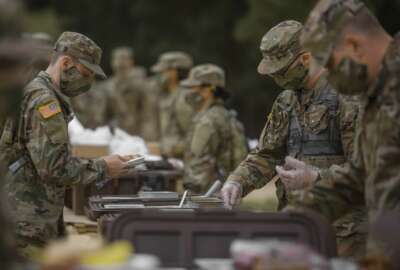Best listening experience is on Chrome, Firefox or Safari. Subscribe to Federal Drive’s daily audio interviews on Apple Podcasts or PodcastOne.
The military’s top official said the Defense Department plans on rolling out vaccines for COVID-19 within the next three weeks. In the meantime, the services are figuring out who in the military should get the shots first.
“Operation Warp Speed leader Gen. Gus Perna is one of the senior logisticians, a great human being, and he’s out there banging away,” Chairman of the Joint Chiefs of Staff Gen. Mark Milley said Wednesday at the Brookings Institution. “He’s going to make sure that we distribute the COVID vaccines nationwide here in a very short order.”
During a Senate Armed Services Readiness and Management Support Subcommittee hearing, Navy leaders explained who in the military will get the vaccine, and how it will be distributed to them.
“There are two related, but separate plans that are in development right now,” said Chief of Naval Operations Adm. Michael Gilday. “The Pfizer medicine will be distributed here in the United States at 10 different locations across the Defense Department. Every medical treatment facility in the military will receive that vaccine. We’ll also have three or four overseas locations that will receive the Moderna vaccine, which is allowed to be refrigerated for up to 30 days. So you have a little bit more flexibility.”
Both of the vaccines are RNA-based and require two shots. The Pfizer vaccine only has a shelf life of about 15 days out in the field.
The Pfizer vaccine is 95% effective and the Moderna vaccine is about 94% effective.
During the early days of the pandemic, the Navy created a prioritization for testing. Gilday said that will give the service an idea of how it will vaccinate its sailors once the shots are approved by the Food and Drug Administration.
“We were building the airplane as we were flying it; as we were trying to get testing capability out,” Gilday said. “This time we have a better sense of what that prioritization structure ought to look like. At the top are health care workers, and then emergency and safety personnel at our installations. Those people are likely to come in contact with people who are infected.”
After that comes strategic forces like cyber operators and troops on missile submarines. Then troops who will deploy in the next three months will get the shot.
“We have a good count of what those numbers are,” Gilday said. “If there’s anything we’re really good at it’s mass immunization in the U.S. military. We feel pretty confident that once we get the vaccine distributed, now that we have the prioritization well thought out, the vaccination will happen pretty quickly.”
Not many people in the military are likely to be top of the list for getting the vaccine in general, however.
The Advisory Committee on Immunization Practices voted on vaccine priority on Tuesday.
The first shots will go to healthcare workers and people in long-term care facilities. The Centers for Disease Control estimates it will need about 48 million doses to vaccinate the 24 million people who fall into those groups.
The military as a whole is still seeing a spike in coronavirus cases. To date, more than 79,000 service members have been diagnosed with coronavirus. More than 30,000 actively have the disease. The military has seen about 10,000 cases in the past two weeks.
Military installations have been rapidly putting restrictions in place. Two weeks ago, 61% of bases were restrictions free. Now, only 48% do not have limits on travel or who can visit bases.
Copyright
© 2024 Federal News Network. All rights reserved. This website is not intended for users located within the European Economic Area.

